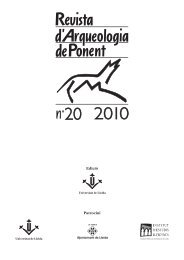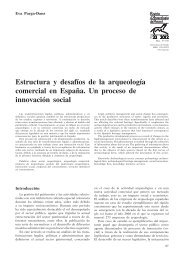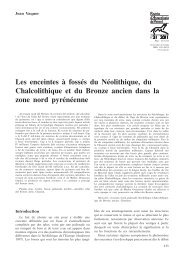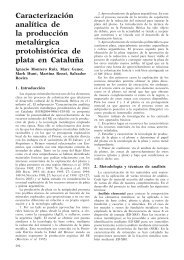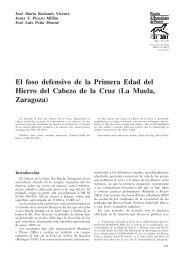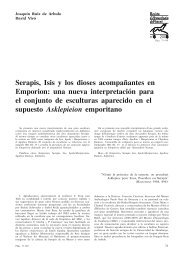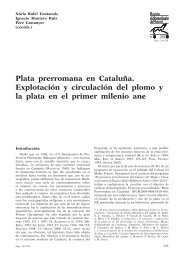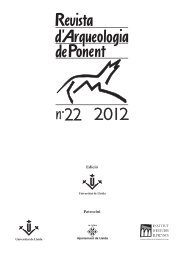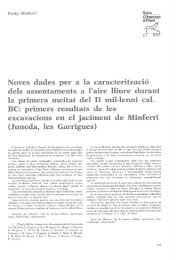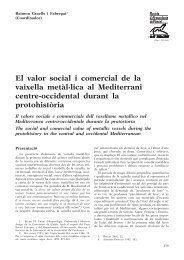- Page 4:
Pasado, presente y futuro de la eco
- Page 9 and 10:
La contribución que se propone con
- Page 11 and 12:
Todas estas características las en
- Page 13 and 14:
como la boda de una eminencia o el
- Page 15 and 16:
consecución de comida y que es la
- Page 17 and 18:
tras que los bienes de alto estatus
- Page 19 and 20:
El caso de SetefillaEl segundo caso
- Page 21 and 22:
No estamos de acuerdo con estas cr
- Page 23 and 24:
local/no local a la hora de tratar
- Page 25 and 26:
incluso la alta cantidad de horas p
- Page 27 and 28:
BibliografíaAl c i n a Fr a n c h
- Page 29 and 30:
Ho m e rHomer, Odyseja, traducción
- Page 32 and 33:
Raúl Balsera MorañoJoan-Manuel Co
- Page 34 and 35:
Fig. 2. Planta general donde se mue
- Page 36 and 37:
Fig. 5. Marco físico del territori
- Page 38 and 39:
SILO 301 NFR NFR NFR NMI NMI NMI NB
- Page 40 and 41:
Fig. 9. Est. 301: cerámica gris de
- Page 42 and 43:
Fig. 10. Contera de hierro pertenec
- Page 44 and 45:
informe (fig. 13, 2), además de un
- Page 46 and 47:
Cronología e interpretaciónsocioe
- Page 48 and 49:
hispánicas fabricadas a mano donde
- Page 50 and 51:
dentro de contextos del Ibérico An
- Page 52 and 53:
SILO 346 NFR NFR NFR NMI NMI NMI NB
- Page 54 and 55:
Fig. 23. Est. 346: cerámica ibéri
- Page 56 and 57:
Cronología e interpretaciónsocioe
- Page 58 and 59:
Fig. 26. Est. 346: cerámica obrada
- Page 60 and 61:
unas relaciones comerciales ligeram
- Page 62 and 63:
sar la cronología de esta amortiza
- Page 64 and 65:
con arquitectura y urbanismo conser
- Page 66 and 67:
estas áreas subperiféricas o dire
- Page 68 and 69:
Fr a n c è s et al. 2002J. Francè
- Page 70:
Za m o r a 2001D. Zamora, J. Pujol,
- Page 73 and 74:
En el año 1908 se iniciaban oficia
- Page 75 and 76:
pentélico, busto y brazo izquierdo
- Page 77 and 78:
fig. 19) y correspondientes a calip
- Page 79 and 80:
se mencionan “una pieza de un fin
- Page 81 and 82:
3a, b, c. Fragmentos de una “Venu
- Page 83 and 84:
sólo longitudinal sino también so
- Page 85 and 86:
Fig. 10a. Lápida greco-latina IRC
- Page 87 and 88:
específico al uso de la técnica
- Page 89 and 90:
88Fig. 15. Imágenes virtuales trid
- Page 91 and 92: Fig. 17. Comparación de la escultu
- Page 93 and 94: del fervor de los devotos al acerca
- Page 95 and 96: Fig. 21c. Detalle de la mano izquie
- Page 97 and 98: traslados de la escultura y su rest
- Page 99 and 100: 98Fig. 27c i d. Cabezas de Serapis
- Page 101 and 102: Fig. 30. Terracotas helenísticas (
- Page 103 and 104: que recogieron todo el fasto y la s
- Page 105 and 106: Fig. 34. Pequeña imagen entronizad
- Page 107 and 108: Fig. 37. Restitución de la gran es
- Page 109 and 110: saqueo de la isla provocado por las
- Page 111 and 112: Fig. 43. Museu d’Arqueologia de C
- Page 113 and 114: Una posibilidad diversa para interp
- Page 115 and 116: Fig. 46. Nápoles. Santuario alejan
- Page 117 and 118: Fig. 50. Museu d’Arqueologia de C
- Page 119 and 120: epresentando a su paredra Agathe Ty
- Page 121 and 122: la amapola del delirio místico, te
- Page 123 and 124: Fig. 58. Pintura del zócalo del ec
- Page 125 and 126: El perirrhanterion y el agua lustra
- Page 127 and 128: Fig. 64. Planta de la Neápolis emp
- Page 129 and 130: gran fiesta que conmemoraba la aper
- Page 131 and 132: piter, por su poder omnímodo, pero
- Page 133 and 134: Hat z f e l d 1919J. Hatzfeld, Les
- Page 135 and 136: Ro d à 1992I. Rodà, “L’Asclep
- Page 140 and 141: Juan Carlos GuixPàgs. 139-145Iron,
- Page 144 and 145: Fig. 3. Adhesive fruiting body of X
- Page 146: Ma n z a n o et al. 2005P. Manzano,
- Page 149 and 150: Fig. 1. Situació del poblat i necr
- Page 151 and 152: allargassat i en esperó segons la
- Page 153 and 154: Fig. 3. Situació de la distribuci
- Page 155 and 156: é el guix és un material més emp
- Page 157 and 158: Fig. 5. Tapadora de guix amb emprem
- Page 159 and 160: Fig. 7. Tapadora de guix sense empr
- Page 161 and 162: Fig. 9. Tapadora de guix amb emprem
- Page 163 and 164: Fig. 11. Tapadora de guix restaurad
- Page 165 and 166: Fig. 13. Tapadora de guix amb empre
- Page 167 and 168: Fig. 15. Tapadora de guix amb empre
- Page 169 and 170: Fig. 17. A dalt, tapadora cònica.
- Page 171 and 172: Fig. 19. Tapadora de guix sense emp
- Page 173 and 174: L-10165 (A40)Tapadora de forma circ
- Page 175 and 176: 174Fig. 22. Fragments de tapadores
- Page 177 and 178: Fig. 23. Tapadora de guix amb empre
- Page 179 and 180: 178Fig. 25. Fragments de tapadores
- Page 181 and 182: localitzat a 47 cm de profunditat a
- Page 183 and 184: s’observen les marques del teixit
- Page 185 and 186: ques incises que no presenten empre
- Page 187 and 188: Fig. 29. Tipologia de les vores de
- Page 189 and 190: quatre fragments amb vora bisellada
- Page 191 and 192: (Pl e n s 1986, 84-85, fig. 48; Pl
- Page 193 and 194:
192Fig. 31. Fragments de tapadores
- Page 195 and 196:
i Pita Mercé (Go n z á l e z 2003
- Page 197 and 198:
eren teles i/o estores (71,43%), qu
- Page 199 and 200:
segle v i i i una perdurabilitat al
- Page 201 and 202:
Ga l l a rt, Ju n y e n t 1989J. Ga
- Page 203 and 204:
Ri p o l l 1959E. Ripoll, “El pob
- Page 205 and 206:
fundamentados en que todo movimient
- Page 207 and 208:
El Sentido de Circulación del Agua
- Page 209 and 210:
Vasos de VicarelloVaso 1 Vaso 2 Vas
- Page 211 and 212:
Fig. 5. Comparación entre el camin
- Page 213 and 214:
Fig. 7. Simulaciones aplicando el f
- Page 215 and 216:
de la Quintana, a unos 20 kilómetr
- Page 218 and 219:
Josep Miret i MestrePàgs. 217-240L
- Page 220 and 221:
condicions de conservació del gra
- Page 222 and 223:
Fig. 1. Secció de diverses sitges
- Page 224 and 225:
de 1990, i els grans no van sofrir
- Page 226 and 227:
Fig. 3. Sitja experimental de Břez
- Page 228 and 229:
de diàmetre superior i 1,50 m de p
- Page 230 and 231:
afectat els cinc anys de conservaci
- Page 232 and 233:
5201510500 5010 0150200353025201510
- Page 234 and 235:
gra eren més altes que en els altr
- Page 236 and 237:
de les llavors, encara que es conse
- Page 238 and 239:
Ba rta l i, Af i f 1988E. H. Bartal
- Page 240 and 241:
Le m e s s a, Bu lt o s a , Wa k g
- Page 244 and 245:
Núria Rafel FontanalsIgnacio Monte
- Page 246 and 247:
El área minerometalúrgicadelBaix
- Page 248 and 249:
Cova dels XaragallsTurons de Riudab
- Page 250 and 251:
Fig. 3. Poblamiento de la primera E
- Page 252 and 253:
Fig. 7. Cálculo de caminos óptimo
- Page 254 and 255:
EraCasetaÀreaExcavadaN.C.sobre la
- Page 256 and 257:
el Barranc d’en Bas constituye un
- Page 258 and 259:
Fig. 13. El Calvari del Molar, estr
- Page 260 and 261:
10 cmFig. 15. El Calvari del Molar:
- Page 262 and 263:
AB1B2A5 cm.3 cm.435 cm.Fig. 16. El
- Page 264 and 265:
Fig. 17. Selección de piezas de pl
- Page 266 and 267:
Fig. 20. Vista, desde el este, del
- Page 268 and 269:
2? 31?47659810?111213?Plomo:PlataIb
- Page 270 and 271:
lo contrario, el estudio realizado
- Page 272 and 273:
Fig. 23. Vista general de la ciudad
- Page 274 and 275:
Fig. 25. Plano general del yacimien
- Page 276 and 277:
AMugaRhodeFluviàPontósEmporionTer
- Page 278 and 279:
3.1. EmporionPor lo que se refiere
- Page 280 and 281:
femenino destinado a la frente, sob
- Page 282 and 283:
Fig. 34. Aplique discoidal de cobre
- Page 284 and 285:
- Muestra 5828: Divisor (tritartemo
- Page 286 and 287:
del siglo iv o inicios del siglo ii
- Page 288 and 289:
- Muestra PA12523: Nódulo metálic
- Page 290 and 291:
4.2. UllastretPor lo que se refiere
- Page 292 and 293:
y se intensifican sobre todo en la
- Page 294 and 295:
Para la fluorescencia de rayos X se
- Page 296 and 297:
Análisis Mineral Mina Prov Fe Ni C
- Page 298 and 299:
Fig. 52. Análisis por ED-XRF de ga
- Page 300 and 301:
Fig. 54. Escorias de cobre PA12416
- Page 302 and 303:
Fig. 60. Materiales de plomo de El
- Page 304 and 305:
4.6. Objetos de plataDebidos a las
- Page 306 and 307:
y brazalete trenzado de 3 cabos. Su
- Page 308 and 309:
La moneda PA12278 presenta además
- Page 310 and 311:
208Pb/206Pb2,132,122,112,12,092,082
- Page 312 and 313:
Vialas en Mont Lozère, en concreto
- Page 314 and 315:
2,1218,92,11518,8518,82,1118,75208P
- Page 316 and 317:
Yacimiento Objeto Inventario Cronol
- Page 318 and 319:
se documenta, ya sea en estado mine
- Page 320 and 321:
BibliografíaAb e l l a et al. 2001
- Page 322 and 323:
Br u g u e r a 2004F. Bruguera, Min
- Page 324 and 325:
Hu n t 2003M. A. Hunt Ortiz, Prehis
- Page 326 and 327:
Po n s et al. 1989E. Pons, J. M. Ll
- Page 328 and 329:
St o s-Ga l e et al. 1995Z. Stos-Ga
- Page 332 and 333:
Memòria del’activitatportada a t
- Page 334 and 335:
Fig. 3a i b: fre de cavall de ferro
- Page 336 and 337:
des sobre el terra rocós de la cov
- Page 338 and 339:
Modern12. Zo n a s u d-o e s t d’
- Page 340 and 341:
47. Pa r c e ò l i c d e Mo n t o
- Page 342 and 343:
Edat del Bronze80. C t r a. Té r m
- Page 344 and 345:
116. Ca s t e l l d e Ma l g r at (
- Page 346 and 347:
Període: Medieval.Dates intervenci
- Page 348 and 349:
Llista d’intervencions de l’any
- Page 350 and 351:
33. Re g a d i u Se g r i à Su d,
- Page 352 and 353:
Ibèric66. A n t o n a (Artesa de S
- Page 354 and 355:
101. Ca s t e l l d e Ma l d à (Ma
- Page 356 and 357:
Pressupost: 1.716,00 €.Subvenció
- Page 358 and 359:
Pressupost: 0,00 €.Subvenció Cul
- Page 360 and 361:
Fig. 7. Quadre resum de les interve
- Page 362 and 363:
omanes a la Tarraconense. Implantac
- Page 364 and 365:
La REVISTA D’ARQUEOLOGIA DE PONEN
- Page 366:
COL·LECCIÓ MONOGRAFIES D’ARQUEO



